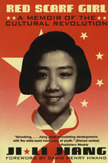
Red Scarf Girl: A Memoir of the Cultural Revolution
So, I actually won a copy of this book on a Goodreads giveaway (Find me on Goodreads here – I’m addicted to it!) and was very excited to get it in the mail.
This book is breathtaking in its window into China during a volatile and scary time called Mao’s cultural revolution (1966-76). During this time, Mao turned to the youth to create a new generation of “revolutionary successors” called the Red Guards. Those Red Guards, through various ways, changed the shape of the education system, through which Jiang was growing up.
The foreword to Red Scarf Girl, by David Henry Hwang speaks of his family’s experience:
When I was a small boy, my grandmother told about a distant uncle who was living in China during the cultural revolution. He promised to send a picture of himself to his relatives in America. If conditions were good, he said, he would be standing. If they were bad, he would be sitting. In the photo he sent us, my grandmother whispered, he was lying down!
Jiang tells her family’s story as they survived and lived during Mao’s revolution in Shanghai. Because Jiang was a young girl at that time, we get to see a young adult’s version of that social revolution, as a twelve year old questioning, listening, and absorbing the world in which she lived. Jiang does an excellent job of bringing this historical world to life, and the reader moves between Jiang’s school, home, and friend’s homes as most young adults do.
The book begins right at the revolution began, in 1966, in destroying the “fourolds” which were old customs, old culture, old habits, and old ideas. Essentially, anything that represented the “old” ways of China. “Two dark trucks blocked the entry. The sides of the trucks were covered with red banners that said things like SWEEP AWAY ALL THE REACTIONARY MONSTERS and DESTROY THE FOUR OLDS AND ESTABLISH THE FOUR NEWS”(Jiang 81). In the beginning of the book, Jiang and her friend, An-li see a group pull down a store’s “old sign” and stomp on it. In the groups excitement and energy, they laugh and cheer, but, at home, Jiang’s grandmother reminds her how destroying property cost that shop owner money.

In the beginning chapters of the book, we see much of Jiang’s conflict at school.
Who would have believed that our entire educational system was wrong after all? Seventeen years after Liberation, the newspapers told us, our schools were not bringing us up to be good red socialists and communists, as we had thought, but revisionists. We thanked heaven that Chairman Mao had started this Cultural Revolution, and that the Central Committee of the Communist Party had uncovered the mess in our schools. Otherwise we would not even have known that we were in trouble. What a frightening idea! (38)
Mao’s revolution was intended to work through the schools, and that was where Jiang came into conflict with the Red Guards – students chosen to lead and remind the other students of how to act and move forward. Because Jiang’s grandfather was a landlord, she was labeled as black whelp, essentially a group to monitored because of their past family. Since her family’s past included owning land, Jiang faces conflicts at school with her friends, the Red Guards, and teachers. She’s teased and harassed as well as turned down for an opportunity with the official dance group because of her family’s status. Jiang becomes angry and frustrated with her family, as many teens do. Jiang does a great job describing her conflicts that each young teenager deals with: parents, teachers, school, friends, and new crushes – yet, those conflicts are amplified by the intensity of living under Mao’s rule.
“Now, you have to choose between two roads.” The man from the revolutionary committee looked straight into my eyes. “You can break with your family and follow Chairman Mao, or you can follow your father and become an enemy of the people.” His voice grew more severe. “In that case w would have many more study sessions, with your brother and sister too, and the Red Guard Committee and the school leaders. Think about it. We will come back to talk to you again.”
He and the woman left, saying the would be back to get my statement. Without knowing how I got there, I found myself in a narrow passageway between the school building and the school-yard wall. The gray concrete walls closed around me, and a slow drizzle dampened my cheeks. I could not go back to the classroom, and I could not go home. I felt like an animal that had fallen into a trap, along and helpless, and sure that the hunter was coming.
Red Scarf Girl is a fascinating and well-written memoir of a young girl’s experience growing up in a dark historical period of China. Furthermore, it’s a memoir of a young girl and her journey in finding herself and becoming aware of her life, her responsibilities, and the importance of her own family. I highly recommend this memoir for older readers (I do recommend mature readers for this – it’s not graphic), especially in high school and college, and even readers who enjoy YA lit – this is a great book for those of us who like historical fictions.
Red Scarf Resources
Ji-li Jiang Biography & Website
Brief Introduction to the Cultural Revolution
Author of Mao’s Great Famine on the Revolution
Teaching Resource from Georgetown University including questions, links, and further reading

Very powerful writing and right from her heart! I can’t wait to pick this up. I think Jiang has a gift and she has put it to use wisely. Thanks for sharing this review at StackingBooks. I am so glad I found this book and your review!
-Reshama